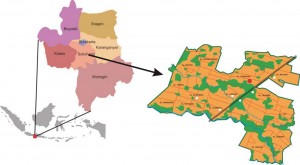Located in Trangsan Village, Sukoharjo District, Solo Region Central Java.
Districts in Central Java Province : Surakarta / Solo, Boyolali, Sukoharjo, Karanganyar, Wonogiri, Sragen, and Klaten., Together they form Solo Raya or Solo Region. The furniture industry in the Solo Region is mostly concentrated in Klaten, Sukoharjo, Sragen and Boyolali Districts.

According to data provided by ASMINDO Surakarta there are 216 furniture exporters in the region (2007), mostly in the abovementioned 4 Districts. Out of them 23 are rattan furniture exporters. Total direct employment in furniture manufacturing (without material suppliers etc.) in the region is around 42,000 people. This includes factories as well as subcontractors and home industries. 23 rattan furniture exporters cooperate with a network of around 410 home industries. Rattan furniture production accounts for an employment of around 8,000 out of 42,000. Output of the furniture industry in Solo region is around 690 containers (40 ft) monthly with a total value of US$ 8.7 million per month or US$ 105 million a year. Output is categorized into rattan (30.2%), mahogany (20.2%), and teak furniture (49.6%)
Trangsan Village is situated in the Sukoharjo District. It has a population of around 6,500. It is located 20 minutes from the Solo airport and 15 minutes from the city of Solo, strategically linked through the railways with important cities such as Surabaya, Semarang, Yogyakarta, Bandung, and Jakarta.
Trangsan is a rattan manufacturing village and the center of the rattan furniture cluster in Sukoharjo District. With the growth of the industry, additional rattan industries have been established in the village surroundings, as well as in the Sub-District area called Gatak or traditionally called Gawo.
The history of the Trangsan/ Sukoharjo rattan cluster dates back to as early as 1920 when 5 craftsmen were reportedly producing rattan furniture such as dining sets, terrace sets and baby cradles for the Kasunanan royal family. Real growth of the industry took place since the 1980s when the center expanded from around 5 home industries producing for the local market in 1980, to 9 exporters supported by 210 home industries in 2000, and 23 exporters with 410 home industries in 2006. A boom was experienced starting in the economic crisis of the late 1990s, initiated by strong export growth. Reports link this to the devaluation of the Indonesian currency, which facilitated exports and at the same time provided windfall profits to manufacturers who were paid in US$. Today rattan furniture production is almost completely for export. Producers/ home industries in Trangsan and nearby villages are linked to major rattan furniture exporters located in the village and its surrounding environment, in Sukoharjo and Surakarta/ Solo. Furniture producers in Trangsan and its environment manufacture rattan and combination furniture using wooden frames, rattan, and substitute materials such as sea grass, banana leaves, water hyacinth, and synthetic materials.